Frank G. Zalom, Director
California Statewide IPM Project
University of California
Davis, CA 95616
The development of synthetic pest control chemicals during and after World War II, in combination with improvements in application technology, dramatically increased the potential for farmers to control insects, pathogens, weeds and nematode pests. Pest control researchers, government agencies, and the agricultural industry overwhelmingly embraced and perfected the technology. California growers were no exception. The rapid expansion of California's agriculture and its ability to produce a variety of high value fruits and vegetables made pesticides an important and economical way of reducing production risks and increasing yields.
It did not take long for problems associated with the chemical pests controls to be observed. Insects, formerly under natural control by predators and parasites, began to cause significant damage. The insects themselves became genetically resistant to chemicals applied for their control, and actually caused greater damage in some cases after being released from the action of their natural enemies and competitors. These phenomena were eventually observed among other categories of pests as well. Agricultural workers began to report illnesses from exposure in the workplace. The impact of pesticides on the environment became established, and was brought to national attention by Rachel Carson's book Silent Spring.
The science of managing pests in California's agriculture without total reliance on pesticides continued to develop during this period. During the 1950's, researchers at the University of California warned of the danger of relying on a single pest control approach. The term of "integrated control" was used in the literature by Michelbacher and Bacon (1952) to describe the integration of insecticides and biological control in California walnut orchards. Stern et al. (1959) used the term "integrated pest management" to incorporate the concept of economic thresholds with the integrated control approach.
Just as many University of California Experiment Station and Cooperative Extension staff were leaders in the development of IPM, several Californians pioneered the concept of "supervised control" which brought pest management knowledge and information from private consultants to their grower clientele. A few of these crop consultants entered the field in the 1950's, and provided a model for today's crop consultants or pest control advisers.
University of California scientists were leaders in organized IPM research nationally through USDA and US Environmental Protection Agency supported programs such as the Adkisson Project and the Huffaker Project. Increased IPM research and extension activities in the 1970's accelerated the development of the consulting industry, and the need for crop consultants in implementing IPM systems became apparent. USDA-sponsored Extension IPM pilot projects for cotton and pears (e.g. Barnett et al. 1979) during this period played a significant role in demonstrating the economic value of information provided by consultants to growers. Both of these pilot projects showed that growers utilizing crop consultants cut their production costs, and typically reduced their pesticide inputs as well. An IPM manual for pears, targeted to both growers and their crop consultants, was produced by the University of California as part of the pear pilot project.
Also in the 1970's, elements of California's rapidly growing urban population focused their attention on pesticide related issues, especially those effecting the environment, the safety of agricultural workers, and pesticide residues on food. California's already extensive pesticide regulatory structure within the Department of Food and Agriculture (CDFA) was expanded, and became unquestionably the strongest in the United States. In 1971, the state began licensing Pest Control Advisers (PCA's). By law, anyone (except for public sector representatives specified by law) who offers a grower a recommendation to use a pesticide or any other pest control method or device must be licensed by the California Department of Pesticide Regulation as a Pest Control Adviser. In the mid 1970's, the CDFA established an Environmental Assessment Team to study pesticide use and alternatives. They published a report in 1978 calling for, among other things, expanded research into alternative pest control strategies (specifically IPM), research on measures which would reduce pesticide hazards, and preparation of materials which would recommend pest monitoring procedures, control actions and thresholds, pesticide hazards, and other management considerations.
Responding to the need to coordinate and expand IPM activities within the University of California which was increasing dramatically with the technical and regulatory activities of the 1970's, University of California Vice President for Agriculture and Natural Resources, James B. Kendrick, appointed Andrew Gutierrez of UC Berkeley to chair an Advisory Committee for the Development and Implementation of a Statewide Integrated Pest Management Program in California. The Committee members included Howard Ferris, David Gilchrist, Robert Luck, Robert Norris, Christine Shoemaker, Ivan Thomason, and Sherman Thomson. Their report described technological needs, and proposed an institutional structure to coordinate and manage such a program.
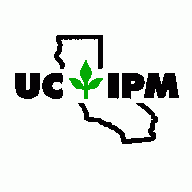
In 1979, the University of California Statewide IPM Project (UCIPM) was approved as a special legislative appropriation for the University's budget. The legislature specified that in addition to funding short-term research, the University would hire a group of Extension IPM Specialists to implement IPM, write a series of IPM manuals, and develop a computer network for delivering pesticide registration information, management guidelines, and predictive models. UC Riverside nematologist Ivan Thomason was named Project Director, and Andrew Gutierrez Associate Director. Project staff was recruited during 1980, and funds were first available for research that field season. The stated goals of the IPM Project are to:
- reduce the pesticide load in the environment,
- increase the predictability and thereby the effectiveness of pest control techniques,
- develop pest control programs that are economically, environmentally and socially acceptable,
- marshal agencies and disciplines into integrated pest management program, and
- increase the utilization of natural pest controls.
Major research and extension activities were initially focused on eight commodities: alfalfa, almonds, citrus, cotton, grapes, rice, tomatoes, and walnuts, which were selected by the Legislature because of their value to California, number of acres in production and pesticide use. Planning for research and funding recommendations were made by Workgroups in each of the commodity areas. Overall program guidance was provided by a Public Advisory Committee and a Technical Committee comprised of faculty representing multiple disciplines and University of California units. In 1987, IPM Workgroups were restructured to emphasize several focus areas for IPM research. Current IPM research is structured into workgroups for applied field ecology, biological controls, biorational uses of chemicals and biotic agents, cultural controls and decision support.
The Statewide IPM Project is a part of the University of California's Division of Agriculture and Natural Resources (DANR), and helps to facilitate and coordinate IPM research and extension activities that occur throughout the University's Experiment Station and Cooperative Extension. The project is headed by a Director who reports to the DANR Associate Vice President for Programs. An Associate Director for Research provides liaison with IPM researchers at the various UC campuses and field stations and chairs the project's Technical Committee. The project has about 30 permanent staff members, and a number of casual employees.
Over the past 16 years, the Statewide IPM Project has supported over 270 research projects proposed by faculty of the Berkeley, Davis and Riverside Campuses as well as Cooperative Extension. Over 130 faculty have served as members of IPM Workgroups which help to set research priorities for the program, and review proposals and progress reports. Dr. Phil Roberts of UC Riverside is IPM Project Associate Director, and he chairs the Technical Committee.
A review of the research funded during the program's first fifteen years indicated 68% involved two or more researchers, 38% two or more disciplines, and 36% two or more institutions. The primary outcome of the sponsored research included developing, testing or refining nonchemical control methods (48% of projects), and developing decision-making procedures or sampling programs (46% of projects). Twenty-five percent of the projects led to reduction in pesticide use. These surveys confirm that the IPM Project continues to address its missions of fostering interdisciplinary and interagency research, reducing the pesticide load, increasing the predictability and thereby the effectiveness of pest control techniques, and increasing utilization of natural pest controls.
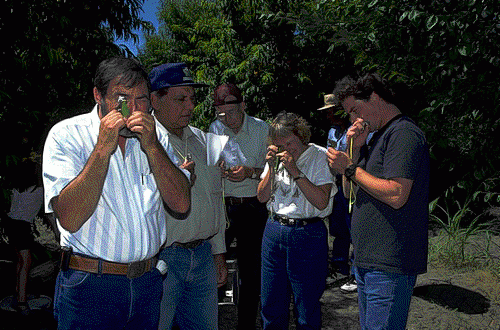
The IPM Project employs a group of eight Area IPM Farm Advisors who are located in important agricultural production regions of California. Four are housed in county extension offices in San Diego (Cheryl Wilen), Santa Rosa (Lucia Varela), Ventura (Phil Phillips) and Yuba City (Carolyn Pickel), and a team of four representing the disciplines of entomology (Walt Bentley), nematology (Pete Goodell), plant pathology (Jim Stapleton) and vegetation management (Tim Prather) are headquartered at the UC Kearney Agricultural Center in Fresno County. These individuals adapt and implement research-based IPM practices in the field (Figure 2). Their primary contacts are Cooperative Extension Farm Advisors, and secondarily licensed Pest Control Advisers who consult in their areas. They are linked closely with the Statewide IPM Project's research program, and its information systems, publications, and pesticide education groups.
In 1988, the Statewide IPM Project began administering the USDA-Extension Smith-Lever IPM 3d Special Project funds which come to California, and they are used to support demonstrations, field days, and other extension activities intended to encourage growers and homeowners to adopt IPM practices. Dr. Pete Goodell serves as Extension IPM Coordinator.
Dr. Mary Louise Flint directs the IPM Project's Education and Publications group which produces pest management publications and training programs for Pest Control Advisers, as well as homeowners and landscape professionals. During the first five years of the IPM Project the major emphasis was on the development of IPM manuals for the agricultural crops targeted by the Legislature. Now, a variety of publications are produced which include the University of California Pest Management Guidelines, and a series of Pest Notes for homeowners. Fourteen IPM manuals have been produced since 1981 (Figure 3) for agricultural crops, landscape trees and shrubs, and home gardens. Several are in their second or third edition. They represent the combined wisdom of research and extension staff at the University of California, and have been important both in disseminating research-based information and in identifying data gaps. The books have received national recognition for their quality and excellent color photographs.
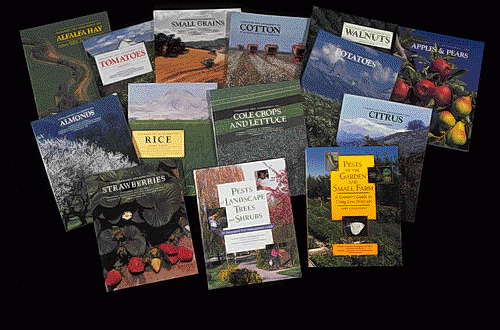
The Pest Management Guidelines are companion publications that contain approaches suggested by University of California specialists for making pest management decisions for specific pests. Information is presented for 34 agricultural crops and turfgrass, and includes sampling and monitoring methods, treatment thresholds, selected pesticides and alternatives to pesticides. When available, organically acceptable management approaches are presented as well. Camera-ready copies are sent to county Cooperative Extension offices for distribution, and are entered into the IPM Project's IMPACT computer for direct access via direct modem access or via the World Wide Web. Subscriptions to the full set of Guidelines (including periodic revisions) are also available through UC ANR Publications.
Computers and their application to crop and pest management has been an important focus for the Statewide IPM Project since its inception. The IPM computer system was initially created to support research and extension staff statewide with various tools for improving their productivity, and as a vehicle to transfer models developed by researchers to county-based extension staff. The system was the first readily available computing resource for many county-based Cooperative Extension Farm Advisors. It included common statistical tools and data entry utilities, weather data, and several types of models. The degree-day program made it possible for Farm Advisors to demonstrate the use of insect phenology models for the first time, and the approach became widely adopted by Pest Control Advisers for many important pests such as the codling moth, the pink bollworm, the oriental fruit moth, and the peach twig borer.
Under the management of Joyce Strand, the IPM Computer System has evolved with advancing technology from its initial configuration of terminals linked directly to a central computer, to one featuring a central database and processing system accessible by modem from virtually any microcomputer with its related application programs available for microcomputers (Figure 4). The user base has expanded from campus-based researchers affiliated with the IPM Project and UC Farm Advisors in 11 counties, to access by all University of California research and extension staff and over 500 agencies and private individuals. Primary features of the IMPACT system are the Pest Management Guidelines, a weather database with over 400 stations in agriculturally important areas, various degree-day and management models, and databases of pesticide registrations and total pesticide use reporting developed in cooperation with the California Department of Pesticide Registration (DPR). Microcomputer applications including CALEX/Cotton and CALEX/Rice, expert systems for integrated cotton and rice crop management, and DDU, a powerful degree-day utility.

The IPM Project's weather database is the largest on-line collection of quality controlled current and historic weather data available for California. It includes weather data for many stations dating from 1951. Over 70 of the stations are obtained electronically from automated weather stations which are part of the California Irrigation Management Information System which is operated by the California Department of Water Resources. Although the weather database was developed primarily for research, it has become important to government agencies and pest management consultants as well.
California is unique in requiring reporting of all applications of pesticides applied for agricultural and other commercial purposes to county regulatory officials. In cooperation with the DPR, summaries of these reports are available through the IMPACT system. Data that can be requested include pesticide, crop or site, date of application, county, and type of application (e.g. air or ground). Data reported for the criteria specified include number of applications, pounds (AI) applied, acres treated, and acres planted.
NEMABASE, which was developed by UC Davis nematologists Edward Caswell-Chen, Howard Ferris and Becky Westerdahl with funding from the IPM Project, describes the host status of plant species to plant-parasitic nematodes worldwide. The database gives fast, easy access to information pulled from the scientific literature, including more than 38,000 plant/ nematode interactions.
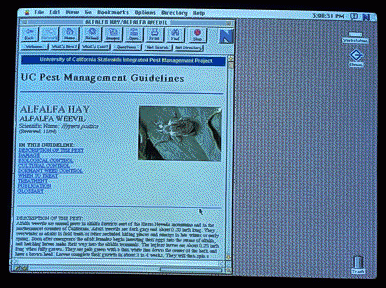
The publications and computer system efforts of the IPM Project are becoming more closely related due to the graphical interface and relatively simple access potential of the Internet's World Wide Web. Databases of the IMPACT system are being combined with the IPM Project's extensive slide library and new publications and databases to permit different and more integrated information systems than were previously possible (Figure 5). The IPM Project Home Page address is http://www.ipm.ucdavis.edu/.
California is somewhat unique nationally in combining the Pesticide Applicator Training and farmworker pesticide safety training responsibilities of Cooperative Extension with its IPM program. Dr. Pat Marer is the Pesticide Safety Training Coordinator with the Statewide IPM Project, and manages its Pesticide Education Program. The program conducts extensive train-the trainer programs for applicator certification and continuing education. It also conducts programs in Spanish for farmworkers who cannot use English as their primary language (Figure 6). During 1994 and 1995, the UC IPM Pesticide Education Program was the only program approved by the US Environmental Protection Agency and the California Department of Pesticide Regulation to qualify instructors to train pesticide handlers and agricultural fieldworkers under the provisions of the Federal Worker Protection Standard. The Pesticide Education Program conducted 49 train-the-trainer programs during 1995. Twelve of these were 8-hour programs for trainers of both pesticide handlers and agricultural fieldworkers. Twenty of the programs featured instruction in Spanish.
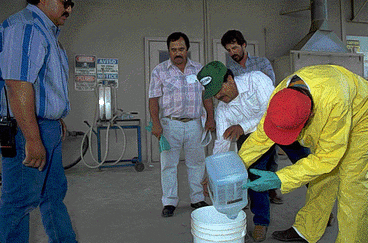
Figure 6. Hands-on training of Pesticide Applicators is an integral part of the Statewide IPM Project.

The Statewide IPM Project has produced a Pesticide Application Compendium Series for pesticide applicators, training videos, and many unique resource publications targeting the Spanish speaking farmworker community (Figure 7). The first book in the compendium series, The Safe and Effective Use of Pesticides, has sold over 25,000 copies nationally. The program is coordinated with the research efforts of the federal NIOSH Agricultural Health and Safety Center which is housed in the UC Davis School of Medicine.
We believe that pesticide safety training and IPM are intimately linked. Pesticide safety is enhanced by preventing exposure. IPM can reduce worker exposure to pesticides by reducing use.
Although it is impossible to precisely assess the overall impact the IPM Project has had on pesticide use, predictability of pest management on the farm level, and coordination of agencies and disciplines related to pest management, it is clear that the program has been responsible at least in part for providing growers and Pest Control Advisers with many practical ways to reduce their reliance on pesticides. Several surveys indicate that growers and their consultants are adopting many practices developed by or promoted through the IPM Project. For example, a 1987 survey of California Pest Control Advisers (Flint and Klonsky 1989) indicated a substantial number used pheromone traps or bait traps, degree-day calculations to predict insect phenology, and University of California guidelines to make treatment decisions for various pests. The survey indicated that 93.8 and 87.1 percent of California Pest Control Advisers working in pome fruit crops and walnuts, respectively, used pheromone or bait traps, degree-day calculations, and UC guidelines for the codling moth. Similarly, 71.5 and 66.1 percent of almond and stone fruit Pest Control Advisers used the practices. More recently, a national survey of tree fruit and nut growers by the USDA Economic Research Service (United States Department of Agriculture 1994) indicated IPM adoption exceeded 50% in many California crops including grapes, oranges and pears.
On its Fifteenth Anniversary in 1994, the California State Legislature passed a joint resolution recognizing the Statewide IPM Project for developing and implementing practices which are being used by California growers to improve their management of pests, and presented the award in a ceremony in the state capitol.
Without question, Federal and California pesticide regulations together with consumer concerns for pesticide residues provided a major impetus for California farmers to experiment with and adopt new approaches for controlling pests during the 1980's and 1990's, but also during this period the IPM Project has tried to help ease farmers through the transition from reliance on conventional pesticides to newer materials or alternative practices with a minimum of economic disruption. Many challenges remain.
The Statewide IPM Project has created a mechanism for identifying and supporting critical short-term research, and a delivery system for reaching pest management decision-makers in the field. The research structure includes the IPM Project Workgroups and grants program, and support from IPM computer databases. The delivery system includes the area IPM advisors and their county Cooperative Extension Farm Advisor cooperators, the IMPACT program, IPM publications including the IPM Manuals and Pest Management Guidelines, continuing education for Pest Control Advisers and pesticide applicators, and farmworker safety training.
Additional information about the program is available in the Annual Report of the Statewide IPM Project which may be requested through the Statewide IPM Project administrative office at UC Davis, or via the Statewide IPM Project Home Page on the World Wide Web.
Selected References
- Barnett, W. W., C. S. Davis, and G. A. Rowe. 1978. Minimizing pear pest control costs through integrated pest management. Calif. Agric. 32(2):12-13.
- Flint, M. L., and K. Klonsky. 1989. IPM information delivery to pest control advisors. Calif. Agric. 43(1):18-20.
- Michelbacher, A. E., and O. G. Bacon. 1952. Walnut insect control in northern California. J. Econ. Entomol. 45:1020-1027.
- Stern, V.M., R. F. Smith, R. van den Bosch, and K. S. Hagen. 1959. The integrated control concept. Hilgardia 29(2):81-102.
- United States Department of Agriculture. 1994. Integrated pest management practices on 1991 fruits and nuts. USDA Economic Research Service RTD Updates. August, 1994, number 2.